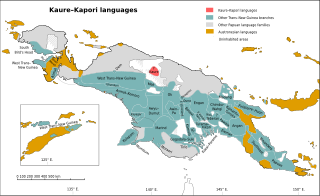 W
WThe Papuan languages are the non-Austronesian and non-Australian languages spoken on the western Pacific island of New Guinea, and neighbouring islands, by around 4 million people. It is a strictly geographical grouping, and does not imply a genetic relationship. The concept of Papuan peoples as distinct from Austronesian-speaking Melanesians was first suggested and named by Sidney Herbert Ray in 1892.
 W
WThe Bulaka River languages are a pair of closely related Papuan languages, Yelmek and Maklew, on the Bulaka River in Indonesian West Papua. They are ethnically Yab (Jab); their speech is Yabga (Jabga).
 W
WThe Chimbu–Wahgi languages are a language family sometimes included in the Trans–New Guinea proposal.
 W
WThe East Geelvink Bay or East Cenderawasih languages are a language family of a dozen Papuan languages along the eastern coast of Geelvink Bay in Indonesian Papua, which is also known as Sarera Bay or Cenderawasih.
 W
WThe Engan, or more precisely Enga – Southern Highland languages are a small family of Papuan languages of the highlands of Papua New Guinea. The two branches of the family are rather distantly related, but were connected by Franklin and Voorhoeve (1973).
 W
WThe Kaure–Kosare or Nawa River languages are a small family spoken along the Nawa River in West Papua, near the northern border with Papua New Guinea. The languages are Kaure and Kosare.
 W
WThe Kiwaian languages form a language family of New Guinea. They are a dialect cluster of half a dozen closely related languages. They are grammatically divergent from the Trans–New Guinea languages, and typically have singular, dual, trial, and plural pronouns.
 W
WThe Lower Sepik a.k.a. Nor–Pondo languages are a small language family of East Sepik Province in northern Papua New Guinea. They were identified as a family by K Laumann in 1951 under the name Nor–Pondo, and included in Donald Laycock's now-defunct 1973 Sepik–Ramu family.
 W
WThe Mairasi languages, also known as Etna Bay are a small independent family of Papuan languages in the classifications of Malcolm Ross and Timothy Usher, that had been part of Stephen Wurm's Trans–New Guinea proposal. They are named after Etna Bay, located in the southeastern corner of West Papua province, in Indonesia.
 W
WThe Papuan Gulf languages are a proposed language family of Papuan languages spoken inland from the large gulf that defines the shape of southern Papua New Guinea.
 W
WPorome, also known as Kibiri, is a Papuan language of southern Papua New Guinea.
 W
WThe Sepik or Sepik River languages are a family of some 50 Papuan languages spoken in the Sepik river basin of northern Papua New Guinea, proposed by Donald Laycock in 1965 in a somewhat more limited form than presented here. They tend to have simple phonologies, with few consonants or vowels and usually no tones.
 W
WTambora is the poorly attested non-Austronesian (Papuan) language of the Tambora culture of central Sumbawa, in what is now Indonesia, that was wiped out by the 1815 eruption of Mount Tambora. It was the westernmost known Papuan language and was relatively unusual among Papuan languages in being the language of a maritime trading state, though contemporary Papuan trading states were also found off Halmahera in Ternate and Tidore.
 W
WThe Trans-Fly – Bulaka River aka South-Central Papuan languages form a hypothetical family of Papuan languages. They include many of the languages west of the Fly River in southern Papua New Guinea into southern Indonesian West Papua, plus a pair of languages on the Bulaka River a hundred km further west.
 W
WTrans–New Guinea (TNG) is an extensive family of Papuan languages spoken in New Guinea and neighboring islands, perhaps the third-largest language family in the world by number of languages. The core of the family is considered to be established, but its boundaries and overall membership are uncertain. The languages are spoken by around 3 million people. There have been three main proposals as to its internal classification.
 W
WThe West Papuan languages are a proposed language family of about two dozen non-Austronesian languages of the Bird's Head Peninsula of far western New Guinea, the island of Halmahera and its vicinity, spoken by about 220,000 people in all. It is not established if they constitute a proper linguistic family or an areal network of genetically unrelated families.
 W
WThe Yam languages, also known as the Morehead River languages, are a family of Papuan languages. They include many of the languages south and west of the Fly River in Papua New Guinea and Indonesian West Papua.